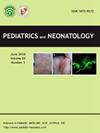Near-infrared spectroscopy (NIRS) as a tool to prevent cerebral desaturation in newborns with bradycardia events: A systematic review
IF 2.3
4区 医学
Q2 PEDIATRICS
引用次数: 0
Abstract
Objective
Near infrared spectroscopy (NIRS) is a non-invasive tool providing real-time continuous measurement of regional cerebral blood oxygenation and indirect blood flow. The aim of this review is to determine the best evidence to guide the use of NIRS to detect and avoid abnormalities of cerebral perfusion and oxygenation in newborns with bradycardia.
Design
For this systematic review according to PRISMA Statement, we reviewed papers from 2000 to 2023. Research articles, trial, classical articles, observational studies applying NIRS in term and preterm neonates with bradycardia were selected if the title and/or abstract suggested an association between bradycardia or bradycardia associated with apnoea and modification of cerebral oxygenation.
Main results
All included studies (Table 1) were conducted on male and female newborns with gestational age (GA) between 22.6 and 42 weeks and birth weight (BW) between 212 and 3460 g. The definition of bradycardia and cerebral desaturation differed among authors. Seven out of nine papers agreed on association between bradycardia and cerebral desaturation, but no author indicated the cut-off of heart rate (HR) under which cerebral desaturations occur. No study focused on long-term outcome related to cerebral desaturation.
Conclusions
Even if cut-off values of HR causing cerebral desaturation are not clear and a well-fixed definition of cerebral desaturation has not yet been standardized, the studies demonstrated that bradycardia events lead to reduction of cerebral saturation. Continuous monitoring of HR and cerebral saturation by non-invasive tools could play a key role in the assessment of newborns.
近红外光谱(NIRS)作为预防新生儿心动过缓事件脑去饱和的工具:系统综述。
目的:近红外光谱(NIRS)是一种实时连续测量局部脑血氧和间接血流量的无创工具。本综述的目的是确定最佳证据,以指导使用近红外光谱检测和避免新生儿心动过缓的脑灌注和氧合异常。设计:根据PRISMA声明,我们对2000年至2023年的论文进行了系统综述。如果标题和/或摘要提示心动过缓或伴有呼吸暂停的心动过缓与脑氧合改变之间存在关联,则选择研究文章、试验文章、经典文章、观察性研究将NIRS应用于足月和早产儿心动过缓。主要结果:所有纳入的研究(表1)均为胎龄在22.6 ~ 42周、出生体重在212 ~ 3460 g的男女新生儿。不同作者对心动过缓和脑去饱和的定义不同。9篇论文中有7篇同意心动过缓与脑去饱和之间的联系,但没有作者指出发生脑去饱和时的心率(HR)临界值。没有研究关注与脑去饱和相关的长期结果。结论:即使HR引起脑去饱和的临界值不明确,脑去饱和的定义也尚未标准化,但研究表明心动过缓事件导致脑饱和度降低。通过无创工具持续监测HR和脑饱和度在新生儿评估中发挥关键作用。
本文章由计算机程序翻译,如有差异,请以英文原文为准。
求助全文
约1分钟内获得全文
求助全文
来源期刊

Pediatrics and Neonatology
PEDIATRICS-
CiteScore
3.10
自引率
0.00%
发文量
170
审稿时长
48 days
期刊介绍:
Pediatrics and Neonatology is the official peer-reviewed publication of the Taiwan Pediatric Association and The Society of Neonatology ROC, and is indexed in EMBASE and SCOPUS. Articles on clinical and laboratory research in pediatrics and related fields are eligible for consideration.
 求助内容:
求助内容: 应助结果提醒方式:
应助结果提醒方式:


